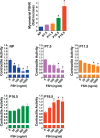Differential Regulation of Human and Mouse Myometrial Contractile Activity by FSH as a Function of FSH Receptor Density
- PMID: 27335068
- PMCID: PMC5029472
- DOI: 10.1095/biolreprod.116.141648
Differential Regulation of Human and Mouse Myometrial Contractile Activity by FSH as a Function of FSH Receptor Density
Abstract
Previous studies from our laboratory revealed that the follicle-stimulating hormone receptor (FSHR) is expressed at low levels in nonpregnant human myometrium and that it is up-regulated in pregnant term nonlaboring myometrium; however, the physiological relevance of these findings was unknown. Herein, we examined signaling pathways stimulated by FSH in immortalized uterine myocytes expressing recombinant FSHR at different densities and showed that cAMP accumulation is stimulated in all cases but that inositol phosphate accumulation is stimulated only at high FSHR densities. Because an increase in cAMP quiets myometrial contractile activity but an increase in 1,4,5-triphosphoinositol stimulates contractile activity, we hypothesized that FSHR density dictates whether FSH quiets or stimulates myometrial contractility. Indeed, in human and mouse nonpregnant myometrium, which express low levels of FSHR, application of FSH resulted in a quieting of contractile activity. In contrast, in pregnant term nonlaboring myometrium, which expresses higher levels of FSHR, application of FSH resulted in increased contractile activity. Examination of pregnant mouse myometrium from different stages of gestation revealed that FSHR levels remained low throughout most of pregnancy. Accordingly, through mid-gestation, the application of FSH resulted in a quieting of contractile activity. At Pregnancy Day (PD) 16.5, FSHR was up-regulated, although not yet sufficiently to mediate stimulation of contractility in response to FSH. This outcome was not observed until PD 19.5, when FSHR was further up-regulated. Our studies describe a novel FSHR signaling pathway that regulates myometrial contractility, and suggest that myometrial FSHR levels dictate the quieting vs. stimulation of uterine contractility in response to FSH.
Keywords: FSH; FSH receptor; contractility; myometrium; parturition.
© 2016 by the Society for the Study of Reproduction, Inc.
Figures






Similar articles
-
Revisiting the follicle-stimulation hormone receptor expression and function in human myometrium and adipose tissue.Mol Med. 2024 Dec 4;30(1):241. doi: 10.1186/s10020-024-01015-2. Mol Med. 2024. PMID: 39633277 Free PMC article.
-
FSH Actions and Pregnancy: Looking Beyond Ovarian FSH Receptors.Endocrinology. 2018 Dec 1;159(12):4033-4042. doi: 10.1210/en.2018-00497. Endocrinology. 2018. PMID: 30395176 Free PMC article. Review.
-
Restoration of human chorionic gonadotropin response in human myometrial smooth muscle cells by treatment with follicle-stimulating hormone (FSH): evidence for the presence of FSH receptors in human myometrium.Eur J Endocrinol. 1996 Feb;134(2):225-31. doi: 10.1530/eje.0.1340225. Eur J Endocrinol. 1996. PMID: 8630524
-
Effects of LH and FSH on androgen and oestrogen release in the myometrium of pigs during the oestrous cycle and early pregnancy.Reprod Fertil Dev. 2020 Oct;32(14):1200-1211. doi: 10.1071/RD20148. Reprod Fertil Dev. 2020. PMID: 33002394
-
Integration of endocrine and mechanical signals in the regulation of myometrial functions during pregnancy and labour.Eur J Obstet Gynecol Reprod Biol. 2009 May;144 Suppl 1:S2-10. doi: 10.1016/j.ejogrb.2009.02.044. Epub 2009 Mar 18. Eur J Obstet Gynecol Reprod Biol. 2009. PMID: 19299064 Review.
Cited by
-
Evaluation of in vivo bioactivities of recombinant hypo- (FSH21/18) and fully- (FSH24) glycosylated human FSH glycoforms in Fshb null mice.Mol Cell Endocrinol. 2016 Dec 5;437:224-236. doi: 10.1016/j.mce.2016.08.031. Epub 2016 Aug 22. Mol Cell Endocrinol. 2016. PMID: 27561202 Free PMC article.
-
Follicle-stimulating hormone receptor expression in advanced atherosclerotic plaques.Sci Rep. 2024 May 3;14(1):10176. doi: 10.1038/s41598-024-60962-2. Sci Rep. 2024. PMID: 38702476 Free PMC article.
-
Extragonadal Actions of FSH: A Critical Need for Novel Genetic Models.Endocrinology. 2018 Jan 1;159(1):2-8. doi: 10.1210/en.2017-03118. Endocrinology. 2018. PMID: 29236987 Free PMC article. Review.
-
Deletion of fetoplacental Fshr inhibits fetal vessel angiogenesis in the mouse placenta.Mol Cell Endocrinol. 2018 Nov 15;476:79-83. doi: 10.1016/j.mce.2018.04.011. Epub 2018 Apr 30. Mol Cell Endocrinol. 2018. PMID: 29715497 Free PMC article.
-
Effects of Follicle-Stimulating Hormone on Human Sperm Motility In Vitro.Int J Mol Sci. 2023 Mar 31;24(7):6536. doi: 10.3390/ijms24076536. Int J Mol Sci. 2023. PMID: 37047508 Free PMC article.
References
-
- Ascoli M, Fanelli F, Segaloff DL. The lutropin/choriogonadotropin receptor, a 2002 perspective. Endocrine Rev. 2002;23:141–174. - PubMed
-
- Gudermann T, Birnbaumer M, Birnbaumer L. Evidence for dual coupling of the murine luteinizing hormone receptor to adenylyl cyclase and phosphoinositide breakdown and Ca+2 mobilization. J Biol Chem. 1992;267:4479–4488. - PubMed
-
- Zhu X, Gilbert S, Birnbaumer M, Birnbaumer L. Dual signaling potential is common among Gs-coupled receptors and dependent on receptor density. Mol Pharmacol. 1994;46:460–469. - PubMed
-
- Donadeu FX, Ascoli M. The differential effects of the gonadotropin receptors on aromatase expression in primary cultures of immature rat granulosa cells are highly dependent on the density of receptors expressed and the activation of the inositol phosphate cascade. Endocrinology. 2005;146:3907–3916. - PMC - PubMed
Publication types
MeSH terms
Substances
Grants and funding
LinkOut - more resources
Full Text Sources
Other Literature Sources

